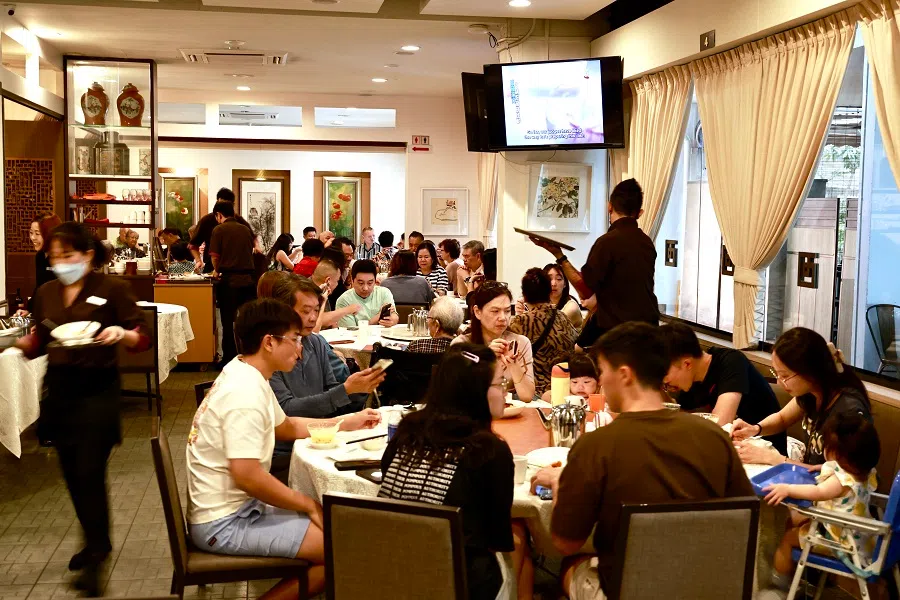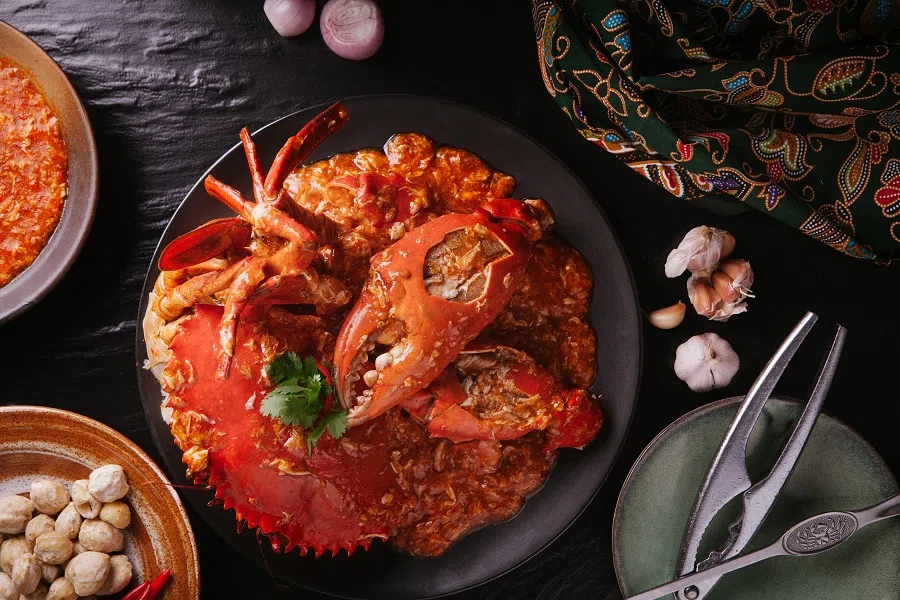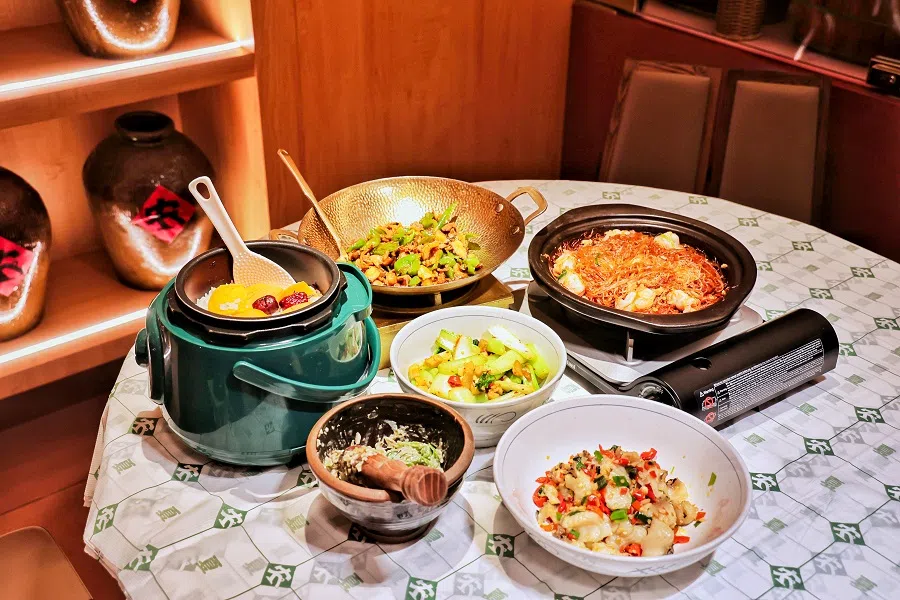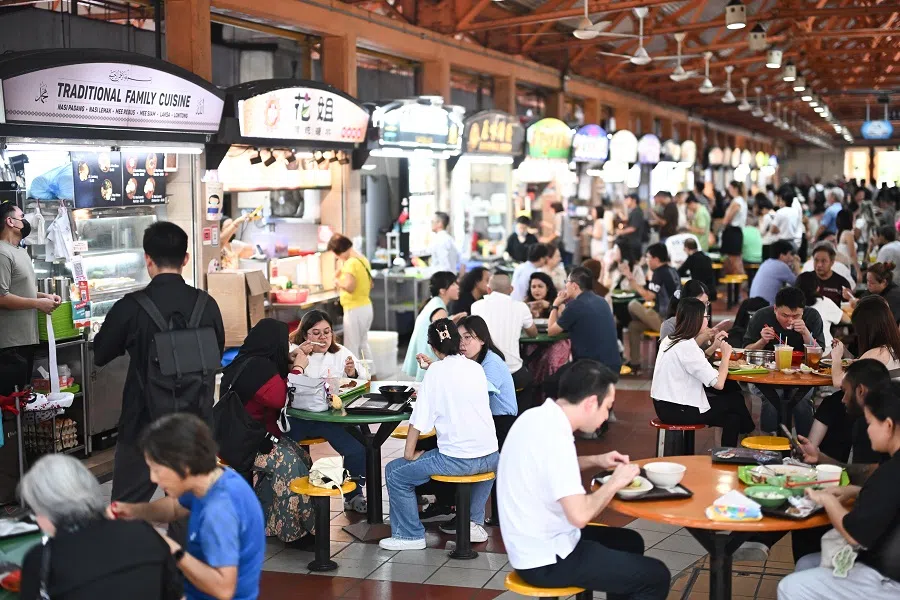More Chinese restaurants joining Singapore’s cutthroat F&B industry
Singapore’s dining scene has seen a rise of new restaurants serving hometown cuisines from various parts of China. Why are so many Chinese restaurants opening in Singapore and what are their strategies? Can local restaurants serving up Nanyang flavours stand out in an increasingly crowded F&B scene? Lianhe Zaobao senior writer Woon Wei Jong finds out.

Opposite Bugis MRT Station, restaurants offering authentic cuisines from all corners of China line both sides of Liang Seah Street.
They include the Chengdu mala chicken (辣子鸡), Liuzhou river snail rice noodles (螺蛳粉), Hunan specialities and Peking duck. Although costlier than in China, the prices are comparable to those at typical Singaporean restaurants. One of the biggest selling points is that one can savour “hometown cuisines” at reasonable prices without flying thousands of kilometres away to China. This is undoubtedly hugely attractive to those who are homesick and those keen to try something new.
On two early evening visits, this reporter observed that new immigrants from China and many local families were among those queueing outside the restaurants.
This influx of restaurants from China — including dominant brands and chains — can also be observed in Chinatown, at many popular dining venues, and even in neighbourhood shopping malls.
According to consulting firm Momentum Works, about 32 Chinese F&B brands were operating 184 outlets in Singapore at the end of June 2024.
While overseas F&B businesses are establishing themselves in Singapore, some local mid-range and high-end restaurants are struggling.

They include Haidilao (海底捞), a hotpot chain that currently operates 19 outlets since venturing to Singapore in 2012, and brands that have expanded to Singapore in the past three years, such as Hunan chain Nong Geng Ji (农耕记) and Tai Er Sauerkraut Fish (太二酸菜鱼) from Guangzhou. The latest additions are the Chamoon Hotpot (享月汤皇) chain known for its clear soup hotpot, Ningbo restaurant YongFu (甬府), heritage brand Wowodian (窝窝店) famous for its steamed stuffed buns, and Putien Group’s Hakka Yu (客语), which specialises in Hakka cuisine.
Offering more diverse choices to consumers are the affordably-priced ice cream and bubble tea brand Mixue (蜜雪冰城) as well as Chagee (霸王茶姬), which has made a comeback to the local F&B scene after briefly exiting the market. Not all popular chains offering Chinese hometown cuisines are from China, however. Some restaurants are homegrown, such as Xiangxiang Hunan Cuisine (湘香湖南菜), which opens its 15th outlet in January 2025.
While overseas F&B businesses are establishing themselves in Singapore, some local mid-range and high-end restaurants are struggling. In 2024, famous restaurants such as Tippling Club, and Michelin-starred eateries like Chef Kang’s Private Kitchen and Sommer, closed down.
In 2024, the monthly average number of business entity closures was 20% to 30% more than in the past three years after Covid-19.
According to the Accounting and Corporate Regulatory Authority (ACRA), 3,004 F&B business entities shut down while 3,577 were formed in the first 11 months of 2024. That works out to an average of 273 closures and 325 openings per month, or a respective daily average of nine and 11.
In 2024, the monthly average number of business entity closures was 20% to 30% more than in the past three years after Covid-19. The closure and formation of F&B businesses are the highest in 34 years since records began in 1990. With the addition of unpublished December data, the number of F&B business closures in 2024 will approach a record of 3,352 in 2005, while the number of new F&B businesses is expected to break the record of 3,934 in 2021.
The pressures of survival and overseas expansion
The above data show the extremely rapid pace of elimination and rejuvenation in the post-Covid-19 F&B industry. Experts also emphasise that local restaurants and overseas brands must weather the pressures of survival in addition to pursuing overseas expansion.
According to interviewees and experts, local restaurants face harsh competition because of three challenges — competition from overseas F&B businesses, rising operating costs and the strength of the Singapore dollar, which prompts Singaporean consumers to spend overseas. To overcome these formidable challenges, F&B businesses must consider how to attract customers, reduce costs and enhance competitiveness.
Let us consider manpower costs alone. Based on the information provided by three businesses, the hourly wage for part-time restaurant employees ranges from S$11 (US$8) to S$16, compared to S$8 to S$12 before Covid-19. The hourly wage during the Lunar New Year period — below S$16 before Covid-19 — in 2025 has also soared from S$15 to S$24.
... two main factors that have led to the overseas expansion of Chinese brands are the push of domestic competition in China and the pull of the US-China trade war. — Ang Yuit, President, Association of Small & Medium Enterprises
According to Ang Yuit, president of the Association of Small & Medium Enterprises, the two main factors that have led to the overseas expansion of Chinese brands are the push of domestic competition in China and the pull of the US-China trade war.
Firstly, Covid-19 and China’s economic slowdown have intensified the competition among F&B businesses in China. Secondly, Chinese businesses know they will bear the brunt of the US-China trade war, and must therefore build up their capabilities to expand overseas. These push and pull factors thus encourage overseas expansion, and Singapore is often the first stop for Chinese businesses that venture abroad.
Behind the hard macro data are the livelihoods of the employers and employees in the local F&B industry, as well as the survival of the Chinese F&B businesses that are susceptible to the pressures of intense domestic competition and overseas expansion.

For first-hand insight, Lianhe Zaobao interviewed several local F&B businesses. One is an established neighbourhood restaurant, the other is setting its sights on international expansion, and the last is a Chinese F&B business that is rapidly opening outlets in Singapore. Completing these diverse perspectives are the additional views obtained from consumers and experts.
Chin Lee Restaurant: a popular neighbourhood eatery serving Teochew cuisine for over five decades
Located in the neighbourhood along Bedok North Road, the 52-year-old Chin Lee Restaurant is famous for its Teochew cuisine. In 2020, it opened a branch in Canberra Plaza to serve the neighbourhood in northern Singapore. The restaurant’s specialities include Teochew steamed pomfret, “sio bee” (潮州烧米, a traditional Teochew dumpling that is increasingly difficult to find), Teochew kway teow (菜脯粿条) and fried oyster pancake (蚝煎).
Eric Chua, the 51-year-old second-generation owner and chef of Chin Lee Restaurant, is also president of the Ku So F&B Association (Singapore) and Fengshan Hawkers and Merchants’ Association. He has been paying attention to the challenges facing the F&B industry for a long time.
Chua says that the most painful challenge was Covid-19. He renovated his new outlet at Canberra Plaza but was forced to temporarily close it six days after opening because of the Circuit Breaker measures that prohibited dining in. At the time, he had over 40 employees at two outlets. To keep the restaurant, uphold his promise not to cut wages, and pay the 13th-month bonus, he made the resolute decision to sell his calligraphy and painting collection worth over S$300,000.
This reporter invited Chua and renowned chef Huang Ching Biao, 71, for a conversation to discuss the challenges local restaurants face and possible solutions. Both agree that retaining unique qualities local cuisine, maintaining affordable prices and providing good customer service are the keys to success.
“We aren’t just running a business, we want to make great food... We must also produce every dish with the best ingredients because every person who comes through the door is a guest and every guest must feel at home.” — Eric Chua, Chef-Owner, Chin Lee Restaurant
Chua says that he and his team are most focused on preserving traditional flavours and passing down Nanyang Teochew food culture to future generations. He insists that Chin Lee Restaurant must serve residents in the neighbourhood, maintain reasonable prices, understand customers’ tastes and preferences, and continuously upgrade the menu and decorations to keep up with the times. “We aren’t just running a business, we want to make great food. So we must emphasise sincerity towards our customers, employees, and our food ingredients. We must also produce every dish with the best ingredients because every person who comes through the door is a guest and every guest must feel at home,” he adds.
Chua proudly shares that because he stayed true to his beliefs, he still has fourth-generation regulars. First-generation regulars who used to dine at the restaurant may have passed on, but their grandchildren continue to bring their children to the restaurant. One of his oldest employees had also worked at the restaurant for 42 years, retiring only at the age of 82. “Even I cannot resist our delicious food when I enter the kitchen,” he jokes.

Huang has been in the local F&B industry for 46 years and has trained countless chefs. He believes that local restaurants must be practical to survive. This includes taking a nostalgic approach to cooking by earnestly mastering the essence of the Nanyang cuisine and avoiding gimmicky fusion cuisine. It is also necessary to set affordable prices, take good care of employees, and not be overly calculative.
Both Chua and Huang urge more local youths to learn and carry on culinary skills. Huang says, “Chinese chefs earn more than Western chefs. Youths must not fear hardship and should take on jobs that few people want to. By aspiring to be valued as talents and not just as labour, your chances of success will be greater.”
Jumbo Group: an established local brand venturing abroad
Jumbo Group is a local F&B brand that has survived and thrived by adapting to challenges with a multi-pronged strategy. Firstly, the group is a well-established local brand known for its chilli crab and for training its chefs well. It also developed and acquired local brands to diversify its risks and strengthen itself before expanding overseas and promoting Singapore cuisine locally and internationally. It simultaneously brings in famous overseas brands, with which it collaborates to expand its market locally.

This reporter separately interviewed Ang Kiam Meng, 62, Jumbo Group’s second-generation CEO, and his daughter, Ashley Ang, 34, Jumbo Group’s culinary and cuisine excellence manager. Both shared their experiences in addressing challenges facing their business.
Despite not seeing the light at the end of the tunnel during the three years of Covid-19, the younger Ang says Jumbo Group persevered doggedly. The Group used the amount of time available then to review and improve all aspects of its business and implement digitalisation. It also improved its central kitchen for better quality control of its signature chilli crab and other menu items. The Group invited Huang to train its team of chefs regularly. Ang is also Huang’s only female apprentice, and she has learnt kitchen management skills and how to cook classic dishes from him.
The younger Ang adds that improving food quality and offering good value for money will help Jumbo Group to be “bullet-proof” against challenges from overseas brands.
Jumbo Group has developed the high-end brand Jumbo Signatures at Marina Bay Sands and acquired hawker brand Kok Kee Wonton Noodles. Currently, the Group has 13 F&B brands, including local brand Ng Ah Sio Bak Kut Teh and Hong Kong brand Tsui Wah. In 2025, Jumbo Group will bring in another famous brand from China and launch new menu items for Ng Ah Sio Bak Kut Teh’s 70th Anniversary.
The younger Ang adds that improving food quality and offering good value for money will help Jumbo Group to be “bullet-proof” against challenges from overseas brands. The Group also provides a wide range of brand options to meet differing consumer needs. Apart from diversifying the Group’s investments and risks and expanding its market, she also hopes to learn training and management practices from overseas brands and introduce new ingredients and ideas.
She reveals that her father frequently organises sessions for chefs from the Group’s different brands to develop and taste new dishes. After consolidating the Group’s position in local market, he is currently busy exploring overseas markets. Jumbo Seafood now has 24 stores across 13 Asian cities.

Jumbo Group has earned record revenue for two consecutive years. In his interview, the elder Ang says that in order to sustain local food businesses when overseas brands are emphasising authentic Chinese flavours, it is essential to consistently deliver great food and increase revenue, all while fostering innovation. The industry must innovate “because innovation requires a runway, which in turn needs fuel; otherwise, it will only be a flash in the pan as all parts of the business are interconnected. Doing things in a blind rush is doomed to fail.”
Nong Geng Ji: a Chinese chain that expanded overseas
Sichuan cuisine (川菜), known for its mala (麻辣, a spicy and numbing) seasoning, has been popular for many years. Recently, Xiang cuisine (湘菜, also known as Hunan cuisine, 湖南菜), which has sour, spicy, savoury and fragrant flavours, has become popular in various parts of China. According to Hongcan Industry Research Institute, there were over 117,000 Xiang cuisine restaurants in China in November 2024.
There are over 7,000 Xiang cuisine restaurants in Shenzhen alone, and competition is extremely intense. Among them is Nong Geng Ji (农耕记), a Xiang restaurant chain founded in Shenzhen in 2017, that has 100 outlets in China.
... intense competition in the China market in recent years has prompted many brands to go overseas. Nong Geng Ji has leveraged this to expand its market, build up experience in transnational operations, and seek inspiration for innovation.
Nong Geng Ji’s founder Feng Guohua, 45, started out as a chef. He shares that Singapore is Nong Geng Ji’s first overseas destination. There are now five outlets in Singapore since the first outlet opened in October 2023. He plans to open two more in mid-February 2025, bringing the total to seven outlets. Nong Geng Ji currently also has three outlets in Malaysia and one in Canada.
Feng candidly remarks that intense competition in the China market in recent years has prompted many brands to go overseas. Nong Geng Ji has leveraged this to expand its market, build up experience in transnational operations, and seek inspiration for innovation. Feng reveals that Nong Geng Ji’s recipe for growth is that 90% of its ingredients are from his farms, including “contracting 3,000 mu (亩, one mu is equivalent to 0.067 hectares) of land in Wuchang in Northeast China to specially plant Wuchang rice”. This enables him to control costs and continue to offer authentic Hunan food. He also has R&D teams to ensure quality at the outlets.
Regarding the “open secret” that many restaurant chains in China choose pre-manufactured sauces and use cylindrical machines to stir-fry dishes, Feng claims that Nong Geng Ji does not pre-cook dishes. Instead, the restaurant chain emphasises freshness, stir-frying, and wok hei (镬气, the flavourful ‘breath of a wok’), with chefs painstakingly controlling the heat and cooking with care.

However, Feng also expresses his willingness to use technology. He says that Nong Geng Ji is “happy to explore advanced equipment to improve operational efficiency and food quality” and that “we always ensure authenticity and the best taste and texture for every dish regardless of equipment or technology used”.
Another popular China brand, Tai Er Sauerkraut Fish, has opened seven outlets in Singapore since opening its first store in Jewel in August 2021. Regarding the related questions posed by Lianhe Zaobao, its spokesperson has replied that its headquarters declined to comment. Based on available data, Tai Er Sauerkraut Fish was founded in 2015 and had 654 outlets worldwide in September 2024.
Survival of the fittest for homegrown restaurants in Singapore
Running a local restaurant is becoming increasingly challenging, requiring both self-reliance and support from various quarters.
Tan adds that Singapore’s F&B industry suffers from the combined effects of reduced consumption, a glut of overseas F&B brands, and increases in rental and labour costs.
When interviewed, Vincent Tan, committee member of the Restaurant Association of Singapore and founder of Select Group, notes that the prospects for local restaurants are not optimistic. With the signing of the Johor-Singapore Special Economic Zone agreement on 6 January 2025 and the expected opening of the Johor Bahru-Singapore Rapid Transit System by the end of 2026, more Singaporeans will spend money in restaurants in Malaysia in future due to the convenience of travel and lower costs in Malaysia. As Singapore is more expensive, Malaysians will visit less, “just like the people of Hong Kong spend money in Shenzhen but the people of China rarely consume in Hong Kong”.
Tan adds that Singapore’s F&B industry suffers from the combined effects of reduced consumption, a glut of overseas F&B brands, and increases in rental and labour costs. Therefore, more restaurants may close in the future due to oversupply and intense competition.

“To sum up, it is survival of the fittest. Don’t rush into the F&B business because of its low barriers to entry. Instead, you must adapt to the competitive environment and find your niche. To survive, you must manage the brand well, launch promotions at appropriate times, and find reasonable rent,” he adds.
21-year-old polytechnic student Lin Zhongxian says that the government should support local restaurants in addition to promoting hawker culture. He adds, “I’ve noticed there aren’t many options for local Chinese restaurants in Singapore.” He also believes that local restaurants must also make an effort to attract customers by leveraging on the uniqueness of their cuisine to differentiate themselves from overseas brands.
To avoid getting overshadowed, local restaurants must strive to be distinctive and well-known in order to compete effectively.
Huang remarked that the prices of overseas restaurants offering hometown cuisine are lower than those of high-end restaurants. Such pricing strategies astutely capture the mid-range market with a restaurant environment that is more comfortable than that of food courts. To avoid getting overshadowed, local restaurants must strive to be distinctive and well-known in order to compete effectively.
He also predicts that the Singapore market will soon be saturated and that overseas brands will expand regionally after gaining popularity and consolidating their overseas business models.
This article was first published in Lianhe Zaobao as “中国家乡菜吃香 南洋风味还吃得开?”.





